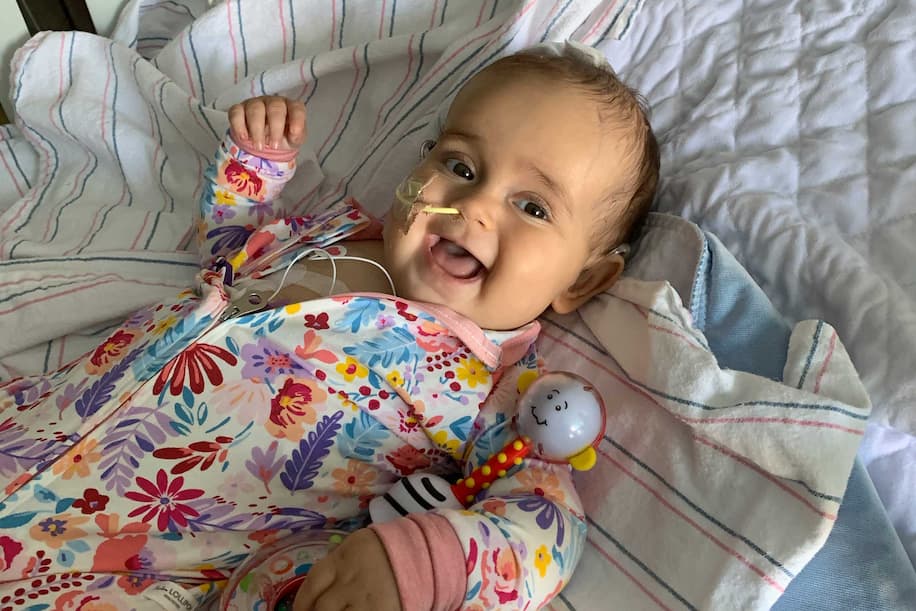Opinion: My baby daughter died of brain cancer. Here’s what we can do to save other kids.
Andrew Kaczynski is an investigative reporter and founder of CNN’s KFile Team.
It was a beautiful September day that began with a long, relaxing walk across Brooklyn, my wife and I taking turns pushing our 6-month-old daughter, Francesca, in her stroller. I remember thinking, “life couldn’t get any better than this.” But that evening, Francesca started vomiting uncontrollably. We raced her to the emergency room.
There, scans showed Francesca had a huge tumor obstructing the flow of fluid in her brain. She was rushed into life-saving surgery, but the diagnosis was an atypical teratoid rhabdoid tumor, or ATRT, the most common brain cancer in infants and one of the deadliest.
We were shocked. Francesca was a hearty girl who always seemed perfectly healthy. She loved to smile, nap in her carrier and watch Sesame Street videos.
My wife and I are journalists, and when Francesca got sick, we threw ourselves into the worst reporting project ever: learning everything we could about this terrifying disease. Francesca’s diagnosis will always be the dividing line in our lives.
Every year in the United States, some 5,000 children are diagnosed with brain tumors. Brain cancer has surpassed leukemia as the deadliest form of childhood cancer, which is the No. 1 disease-related killer of children under 15. Despite this, there has never been a drug developed and approved specifically for malignant pediatric brain tumors.
My wife and I learned that pediatric oncologists and researchers have worked tirelessly over decades to improve the odds for the 58 people diagnosed with ATRT in the United States every year. The rare cancer, which has a five-year survival rate of only 32 percent, but is nearly always a death sentence for babies, was considered untreatable until a few brilliant oncologists discovered an extremely harsh regimen of chemotherapy and radiation that could save some children.
These ATRT treatments require families to spend months in the hospital, and they still often fail to eliminate the cancer. The few kids who do survive often have major long-term side effects, including seizures, cognitive problems and difficulty walking.
The current treatment is hell, but when it’s your daughter’s only chance, you take it. Francesca required six surgeries — five on her brain and one to put in a stomach tube for feeding. My wife and I watched her suffer the intense chemotherapy’s side effects — uncontrollable vomiting, intense pain and awful digestive system sores.
One night, Francesca had emergency brain surgery because she developed meningitis as a complication of an earlier surgery. Another night, she had seizures following a brain surgery.
The chemotherapy drugs wipe out the immune system, making children highly susceptible to infections from typically innocuous bacteria and fungus in the environment. That’s what happened to Francesca during her third round of chemotherapy. She caught a fungal infection that her little body couldn’t fight off.
She went into septic shock and spent her last month of life sedated on a ventilator. We couldn’t hold her as she slowly succumbed to the infection. We sat next to her, holding her hand those horrible weeks.
She passed away on Christmas Eve.
Our family’s horrific saga is the reality of pediatric cancer. Many families we’ve met have suffered the same fate or are suffering it now.
Improving outcomes won’t be simple. Sadly, given the small market of patients, it’s unlikely that a profit-driven industry will develop a miracle drug for pediatric brain cancers. Instead, fixing the world for our babies will require more of everything: more funding from the National Cancer Institute, the Defense Department’s Peer Reviewed Cancer Research Program and the Rare Cancers Research Program; stronger requirements for the pharmaceutical industry to share drugs with pediatric oncologists; and improved data-sharing.
Because of a lack of interest from pharmaceutical companies, the federal government and charities fund most of the research in this area. Pediatric oncologists have told me they spend considerable time looking for funding. Clinical trials cost millions of dollars and take years.
Legislation has been passed incentivizing drug companies to work on drugs for children, but pediatric oncologists still say access to drugs remains a major challenge and that they are often brushed aside by drug companies.
The drugs are also extremely costly. Requiring the industry to provide researchers free access to their approved and premium-priced drugs could help enterprising oncologists identify promising drugs developed for adult cancers that may work on pediatric brain tumors.
We also need to centralize data so doctors can more easily detect patterns among patients. The top hospitals see at most a handful of children each year with diseases such as ATRT. My wife and I longed to have the data available to make better-informed decisions for our daughter. A federally funded central registry for pediatric brain tumor data is one straightforward solution.
Children with cancer touch a special place in people’s hearts. We’ve received so many incredible messages of support from total strangers that we will always cherish. And yet, as a society, we have failed to put our best resources together.
Let’s start now. We don’t have time to waste.
Source: Washington Post By Andrew Kaczynski
Support families fighting financial toxicity of cancer – here.
